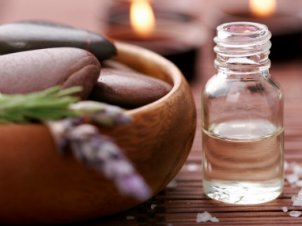Essential Oils commonly used at Spas
By Jessica, January 26, 2008

Records of essential oils being used for medicinal purposes date back thousands of years, and there is archaeological evidence suggesting their use well into prehistory.
The Chinese have records of the health properties of essential oils dating back 4,000 years, Egyptian records show their serious application dating back even earlier. Hippocrates, the father of modern medicine, also prescribed them, while India’s Vedic literature lists more than 700 medicinal oils.
The European Renaissance, with its shift in thinking towards scientific method, saw the separation of active ingredients from whole oils, and eventually the synthesizing these components, eventually giving rise to the to the modern pharmaceutical industry. This caused a fall in the credibility of oil treatments which were then relegated mostly to the role of perfumes.
In the last few decades however, there has been a resurgence in the use of essential oils for their medicinal properties, as more and more people seek alternative forms of treatment to modern drug therapies.
Many of the essential oils listed below, though common in their plant form as flavoring in foods, and perfectly safe in the hands of professionals, are not to be messed with when distilled into essences. They can be very strong. Be sure to read the cautions to make sure you won’t suffer adverse effects.
- BASIL OIL (Ocimum Bascilicum)
Best known for its flavouring properties in food, basil has many therapeutic applications, including as a bactericide, antiseptic, antimicrobial, astringent, antispasmodic, antitoxic, diuretic, antifungal, insecticide, tonic and immune system stimulant. Caution: Can irritate sensitive skin, avoid during pregnancy. - BERGAMOT (Citrus bergamia)
Extracted from the peel of the Italian bergamot fruit, bergamot oil’s is effective as an analgesic, anti-infection, anti-toxic, antidepressant, antiseptic, antimicrobial, astringent, antispasmodic, bactericide, diuretic, digestive, deodorant, expectorant and relief of fever. - CARDAMOM OIL (Elettaria cardamomum)
This sweet-smelling spice is frequently found in Indian foods – particularly desserts. Its therapeutic properties in oil form include: Antiseptic, antimicrobial, aphrodisiac, astringent, antispasmodic, digestive, diuretic and antiflatulant. - CEDAR OIL (Cedrus atlantica)
Cedar wood has long been used for storage cabinets because of its ability to repel insects and prevent decay. In oil form, applied to humans, it is an antiseptic, astringent, expectorant (removes mucus from respiratory system), anti-fungal, sedative and insecticide. - ROMAN CHAMOMILE OIL (Anthemis nobilis)
Extracted from flowers similar to daisies, with a light pleasant aroma, chamomile has many medicinal applications including: Antidepressant, anti-inflammatory, anti-convulsive, anti-neuralgic (nerve pain), reducing inflammation, antiseptic, antispasmodic, anti-allergic, anti-parasitic, promoting menstrual flow, diuretic, digestive and sedative. Caution: Avoid in the first trimester of pregnancy, can irritate sensitive skin. - CINNAMON OIL (Cinnamonum Zeylanicum)
While cinnamon may taste great on toast and in granny’s cookies, it is also a powerful medicine. Therapeutic applications: Antidiarrheal, poison anitdote, antiseptic, antimicrobial, astringent, antispasmodic, bactericide, diuretic, antifungal, insecticide, immunity stimulant and antiparasitic. Caution: Because cinnamon oil stimulates contractions, it should be avoided during pregnancy. - CLARY SAGE OIL (Salvia sclarea)
There are songs about this one, (along with its relatives parsley, rosemary and thyme). It’s great with chicken, but can be very powerful in oil form. Therapeutic applications: Anti-inflammatory, antiseptic, antimicrobial, astringent, antispasmodic, antitoxic, diuretic, antifungal, insecticide, immunity stimulant, mild anesthetic
Caution: Non-toxic but avoid in 1st trimester of pregnancy; may stimulate contractions. Overuse can cause headaches. Doesn’t mix with low blood pressure or alcohol. - CLOVE OIL (Eugenia caryophallata)
A common flavoring in both eastern and western foods, and prized in the early days of the spice trade, clove oil’s therapeutic uses include: Antiseptic, antibacterial, antiviral, analgesic (pain relief), antioxidant, homostatic (blood thinning), anti-inflammatory. Caution: Avoid in pregnancy. Can irritate sensitive skin. Do not apply to children under age 5. - EUCALYPTUS (Eucalyptus globulus)
Though eucalyptis leaves are the only thing Koalas eat, both the leaves and oil are toxic if taken internally. Its medicinal properties are mostly well known: Antiseptic, astringent, antiviral, bactericidal, deodorant, expectorant, fungicidal, sedative and insecticide. Caution: Avoid in pregnancy, if you have high blood pressure or epilepsy. Can irritate sensitive skin. Use no more than a few days at a time. - FENNEL OIL (Foeniculum Vulgaris)
Fennel is usually offered at the end of an Indian meal to aid digestion. Its medicinal applications are: Bactericide, antiseptic, antimicrobial, astringent, antispasmodic, antitoxic, diuretic, antifungal, insecticide, tonic and immunity stimulant. Caution: Avoid in pregnancy. Not good for epileptics. Narcotic in large doses so use in moderation. Do not apply to children under age 5. - FRANKINCENSE (Boswellia carterii)
The three kings who brought gifts to the baby Jesus in that manger would have been well aware of the medicinal properties of frankincense including: Antiseptic, astringent, expectorant, fungicidal, sedative and insecticide. Caution: Do not use frankincense during pregnancy and avoid contact with the eyes and mucus membranes. - GERANIUM (Pelargonium odorantissimum)
Not just a pretty flower. Geranium can also be used as: Antiseptic, astringent, expectorant, fungicidal, sedative and insecticide. Caution: Avoid in first trimester of pregnancy. Can irritate sensitive skin. - GINGER OIL (Zingiber officinale)
Excellent in cookies and teriaki, ginger is powerful medicine. Among its applications as an essential oil are: Bactericide, antiseptic, antimicrobial, astringent, antispasmodic, antitoxic, diuretic, antifungal, insecticide, tonic and immunity stimulant. Caution: Slightly phototoxic; may make some people more sensitive to UV. - LAVENDER OIL (Lavandula vera)
Distilled from the purple flowers much prized as an aphrodisiac in Victorian times (as if they needed one), the oil smells lovely and can function as: antidepressant, antiseptic, astringent, expectorant, fungicide, sedative, insecticide, emollient and anti-inflammatory
Caution: Not good with low blood pressure or in the first trimester of pregnancy. - LEMON OIL (Citrus limonum)
Not only is it fantastic stuff for polishing wood furniture, it’s got benefits for humans as well. Among its many wonders, lemon oil is a: Bactericide, antiseptic, antimicrobial, astringent, antispasmodic, antitoxic, diuretic, antifungal, insecticide, tonic and immunity stimulant. Caution: Can irritate sensitive skin as well as increasing sensitivity to sunlight. Toxic if taken internally. - LEMONGRASS OIL (Cymbopogon citatus)
This tough and tangy grass is what gives many Thai foods their inimitable zing. It’s good for you as well. Its medicinal applications include: Analgesic, antidepressant, antimicrobial, antioxidant, antiseptic, astringent, bactericidal, deodorant, fungicidal, insecticidal, sedative, digestive, itch relief and tonic
Caution: Non-toxic, can irritate sensitive skin. Avoid when pregnant. - MARJORAM OIL (Origanum marjorana)
Another name common on the kitchen spice rack. In oil form, marjoram is useful as: Analgesic, antiseptic, antioxidant, antispasmodic, antiviral, bactericidal, digestive, diuretic, expectorant, hypotensive, laxative, sedative, tonic and, some say, an aphrodisiac. Caution: Not good with pregnancy, low blood pressure, young children or the elderly. - MYRRH ESSENTIAL OIL (Commiphora myrrha)
Another prized gift from the three wise men in the manger. Myrrh, in spite of its bizarre spelling has many therapeutic properties including: Anti-inflammatory, antifungal, antimicrobial, antiphlogistic, anticatarrhal, antiseptic, astringent, expectorant, sedative, and uterine tonic. Caution: Avoid during pregnancy (even if by immaculate conception). - NUTMEG OIL (Myristica fragrans)
A key ingredient in Grandpa’s Christmas eggnog, this spice is psychoactive and even hallucinogenic in large doses – which may help to explain why grandpa always acted a bit funny on Christmas Eve. It can be used as: Bactericide, antiseptic, antispasmodic, antioxidant, tonic, immune stimulant and an aphrodisiac. Caution: Never use if pregnant or lactating. Use very small amounts. Do not use on the elderly, teens or children. Toxic in high doses. - OREGANO OIL (Origanum vulgare)
A key element in the spaghetti sauce of any self-respecting cook, oregano has many benefits in oil form including: Antiviral, antibacterial, antifungal, antiparasitic, analgesic, antiseptic, antispasmodic, diuretic, fungicidal, stimulant and insecticide
Caution: Avoid during pregnancy - PATCHOULI (Pogostemon cablin)
Very popular with blissed-out neo-hippies as a calming perfume, it can also function as: Antidepressant, antiseptic, aphrodisiac, antimicrobial, diuretic, deodorant, carminative, astringent, expectorant, fungicidal, sedative, tonic, decongestant and insecticide.
PEPPERMINT OIL (Mentha piperita)
Traditionally known as a treatment for bad breath and sore teeth, peppermint has a few other applications as well: Analgesic, anti-inflammatory, antiseptic, antimicrobial, antispasmodic, astringent, carminative, digestive, expectorant, fungicidal, nervine, vasoconstrictor, decongestant amnd stimulant. Caution: Avoid in pregnancy and lactation. - WILD ROSEMARY (Rosmarinus officinalis)
One of the herbs in the famous old song, there was much to sing in its praise since it can function as: Antiseptic, analgesic, anti- bacterial, antispasmodic, astringent, diuretic, digestive, fungicidal, stimulant, insecticide, invigorating, nervine, restorative, diaphoretic, decongestant, hypertensive, and antiparasitic. Caution: Avoid in pregnancy. Can irritate sensitive skin. - ROSEWOOD OIL (Aniba rosaeodora)
Rosewood, a popular material for decorative work, can be distilled into medicinal oil that functions as: Bactericide, antiseptic, antimicrobial, astringent, antispasmodic, antitoxic, diuretic, antifungal, insecticide, and immunity stimulant. Caution: Avoid during pregnancy. Can irritate sensitive skin. - SANDALWOOD OIL (Santalum Album)
A pleasant smelling oil popular in incense, Its medicinal applications include: Bactericide, antiseptic, antimicrobial, astringent, antispasmodic, antitoxic, diuretic, antifungal, insecticide, tonic and immunity stimulant - TEA TREE (Melaleuca alternifolia)
This oil has been appearing in everything from shampoos to skin creams over the last few years. Among its medicinal applications are: Anti-fungal, antiseptic, Antibiotic, antibacterial, anti-inflammatory, antiviral, diaphoretic, expectorant, immunity stimulant and decongestant. Caution: Avoid during pregnancy. Can irritate sensitive skin. Avoid prolonged use. - THYME SERPOLET OIL (Thymus vulgaris)
One of many oils that is also good with chicken in its leaf form. Therapeutically it is effective as: Bactericide, antiseptic, antimicrobial, astringent, antispasmodic, antitoxic, diuretic, antifungal, insecticide, tonic and immunity stimulant. Caution: Avoid during pregnancy, or if you have high blood pressure. - YLANG YLANG (Cananga odorata var. genuina)
This headily scented oil may have a funny name, but its medicinal properties are many. It is useful as: Antidepressant, anti-infection, tonic, sweat reduction, antiseptic, euphoric, hypotensive, nervine and stimulant. Caution: Use in moderation – too much can cause nausea or headaches. Not good with low blood pressure. Can irritate sensitive skin.




